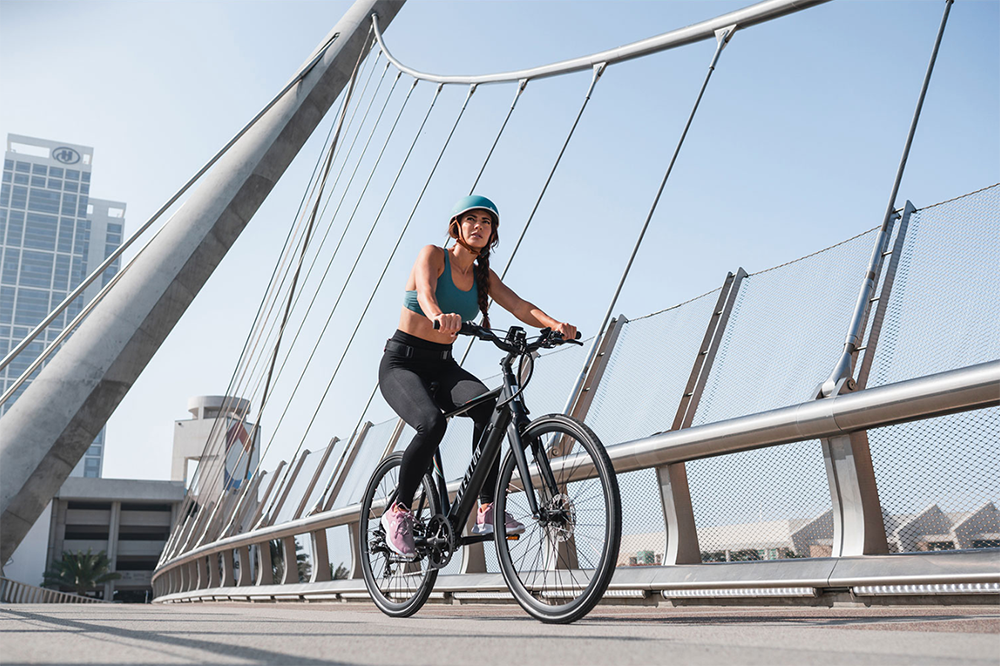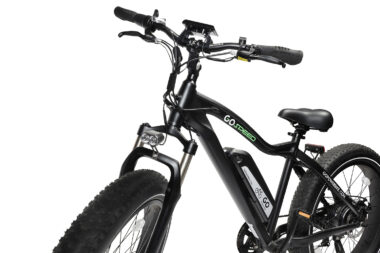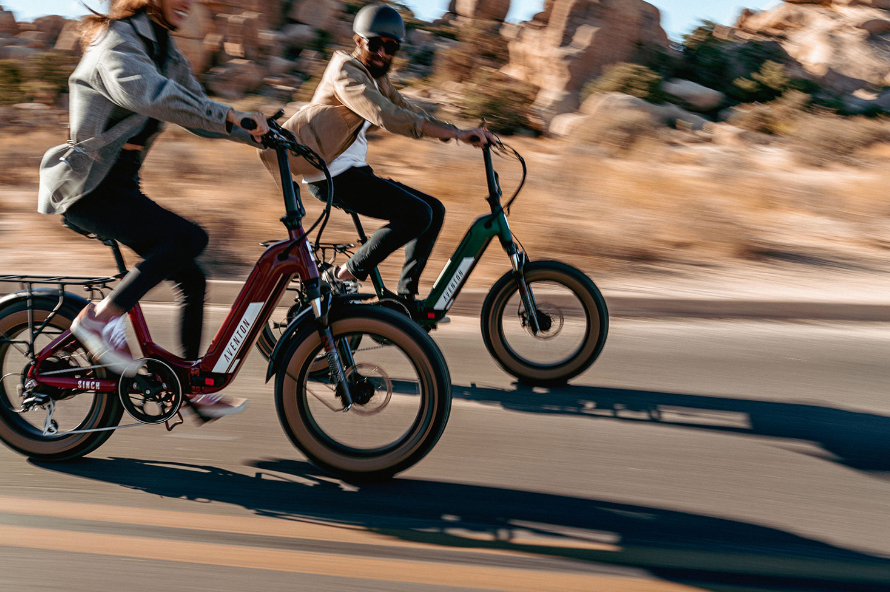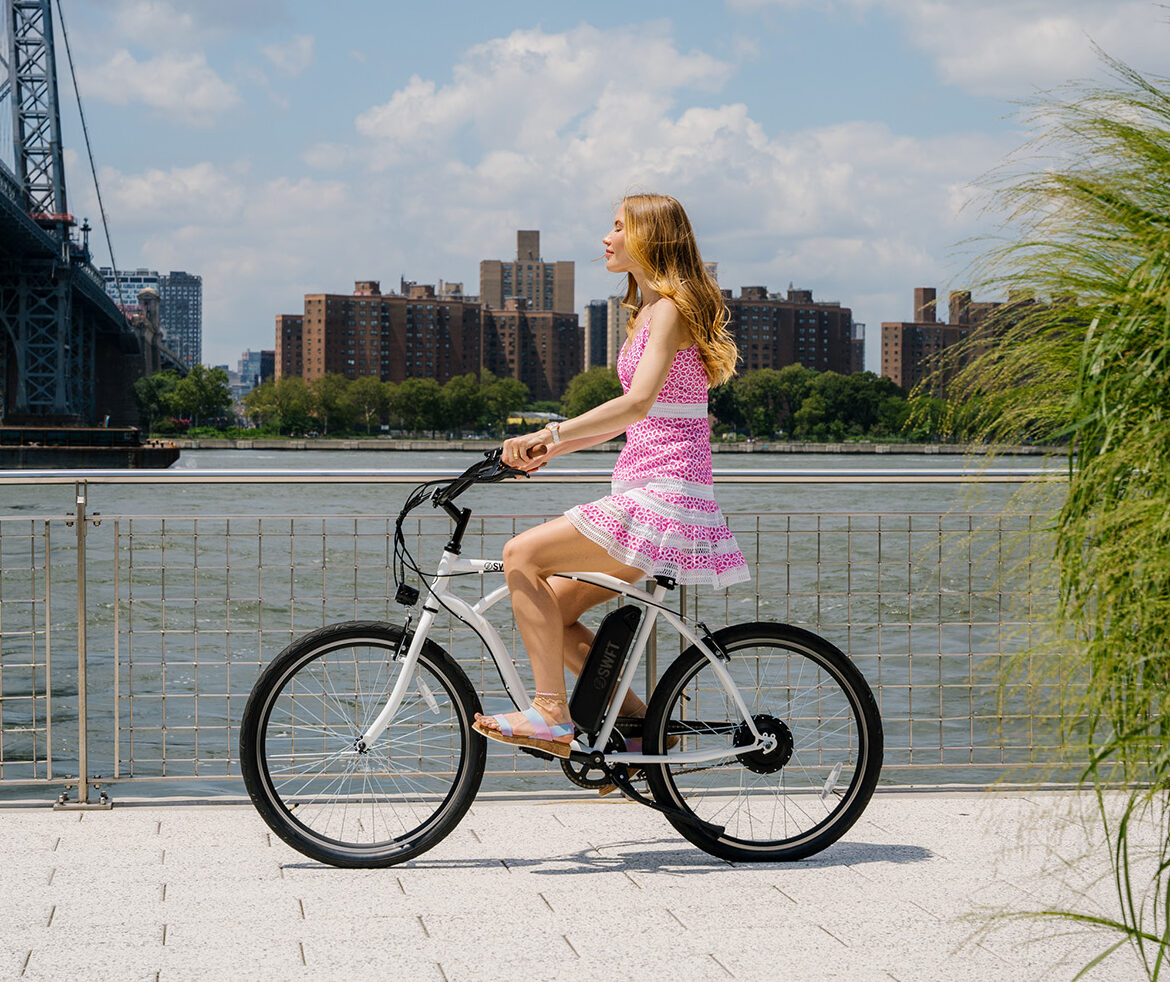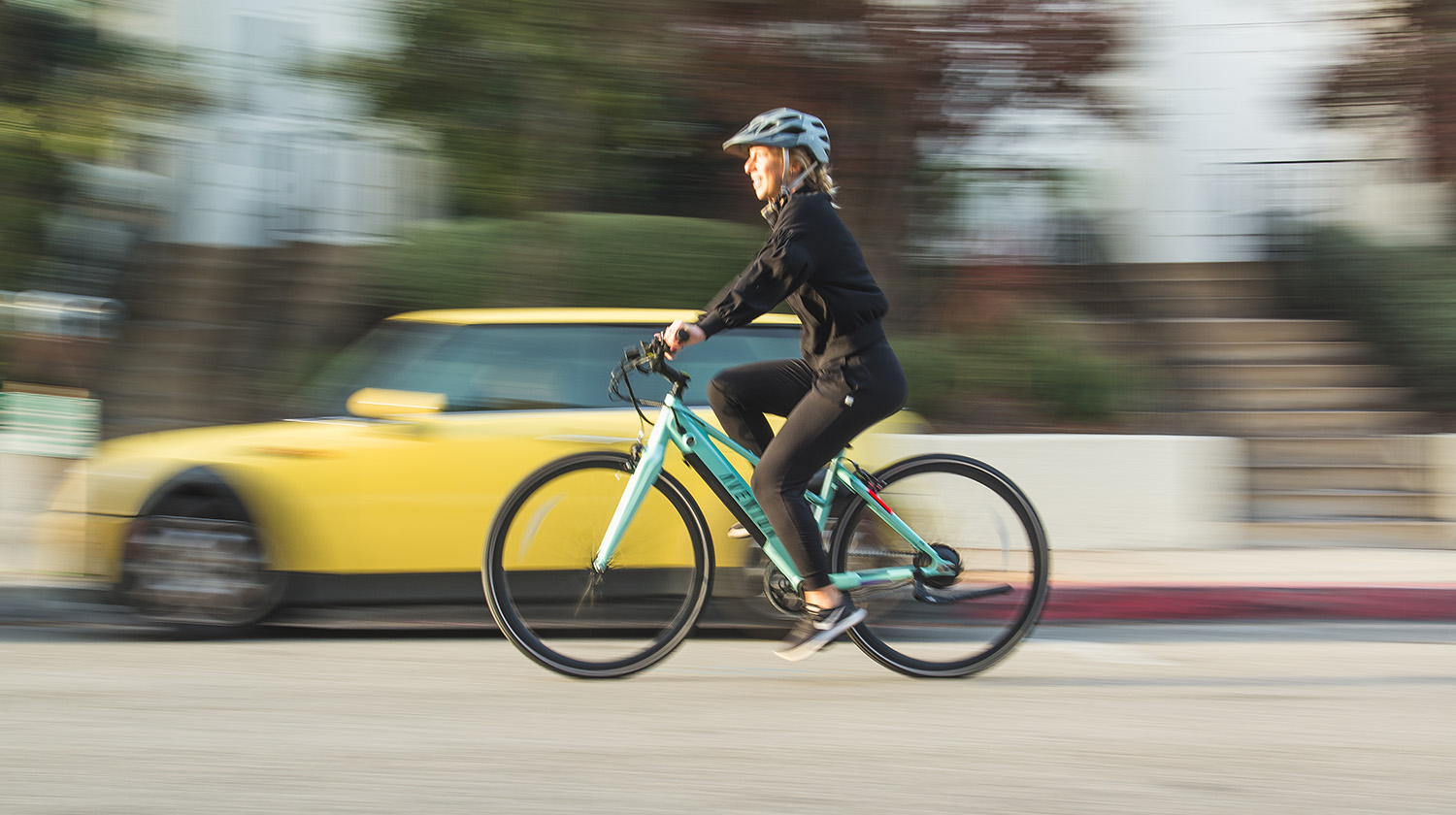
E-bikes or electric bikes are all the rage right now, combining the benefits of a standard bicycle with some motor power to get you going. They are ideal for both active individuals as well as those who might not necessarily have the stamina or skill to pedal away through various terrain. If you’re considering an e-bike, this guide will provide everything you need to know about what e-bikes are, how they work, the different types to choose from, which would be best suited to you, and what features to look for when selecting one.
Table of Contents:
- What is an electric bike?
- Pedal assist versus throttle assist power on e-bikes
- Types of Frames
- Typical range and speed of an e-bike
- Types of electric bikes
- Other factors to consider when choosing an e-bike
What is an electric bike?
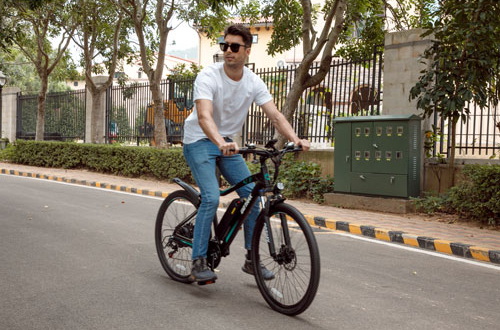
First off, before delving into the nitty-gritty details, what exactly is an electric bike? These are regular bikes that come with a battery-operated motor to provide extra power when you need it. This helps you pedal less when you’re getting tired or just want to cruise, as well as provides the extra power needed to get up steep hills or go through rough terrain.
E-bikes usually have a miniature display that will indicate the speed and battery life, similar to a car’s dashboard display. They may also show what level you’re using if you have a bike with multiple ones, like pedal assist, manual, electric, and walk.
Pedal assist versus throttle assist power on e-bikes
An electric vehicle with two wheels but without pedals is not an e-bike; it might be an e-motorcycle, or e-moped. Most provinces in Canada require an electric bike to have functional pedals (more on regulations below). Most e-bikes, and all available at Best Buy Canada, offer pedal assist, but throttle assist e-bikes are becoming more and more common.
Electric bikes fall into three classes depending on how they are powered which roughly follow these guidelines:
Class 1: pedals must be moving for the battery power to kick in. A throttle might also be present, but it won’t work if the rider is not pedaling. Can’t exceed 32 km/h.
Class 2: throttle can work even without pedaling. Can’t exceed 32 km/h.
Class 3: may or may not have throttled power (depends on region) but can exceed 32 km/h and must have a speedometer.
Depending on where you live, approval may depend on whether the bike is class 1, 2, or 3. Usually, however, the regulations differentiate between pedal assist and throttle assist power on e-bikes. Keep in mind that as new products launch, provincial regulations may adapt. Here’s a rundown of how those two work.
Pedal assist
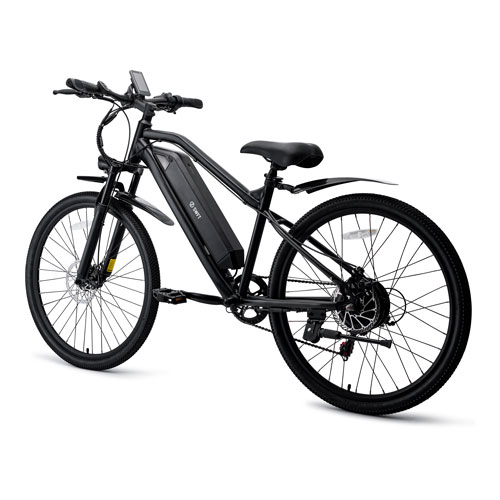
E-bikes with pedal assist offer partial assistance to make driving easier. Once you start pedaling, the motor kicks in. Usually, there are different settings so you can choose the speed and level that suits your trip. You can usually get to higher speeds with a bike that has pedal assist since it combines both your manual footwork and the extra assistance of the motor. E-bikes that are regenerative also recharge the bike once you apply the brakes. If the battery dies while you’re out and about, you can continue riding by manual pedaling alone.
Throttle assist
More e-bikes nowadays include throttle assist, which allows for a complete takeover of power so you can cruise without ever moving your legs. This is similar to the cruise control feature in a vehicle. Unlike with pedal assist, where you have to pedal for the motor to engage, full throttle simply goes once you twist the throttle or use your thumb, much like with a motorcycle.
Many e-bikes on the market today come equipped with both pedal assist and throttle assist modes, allowing riders to choose between pedaling with electric assistance or simply using the throttle to power the bike. This versatility makes them a popular choice for commuters, recreational riders, and anyone looking for an eco-friendly alternative to traditional transportation.
Frame type
There are three main types of e-bike frames, similar to regular bikes.
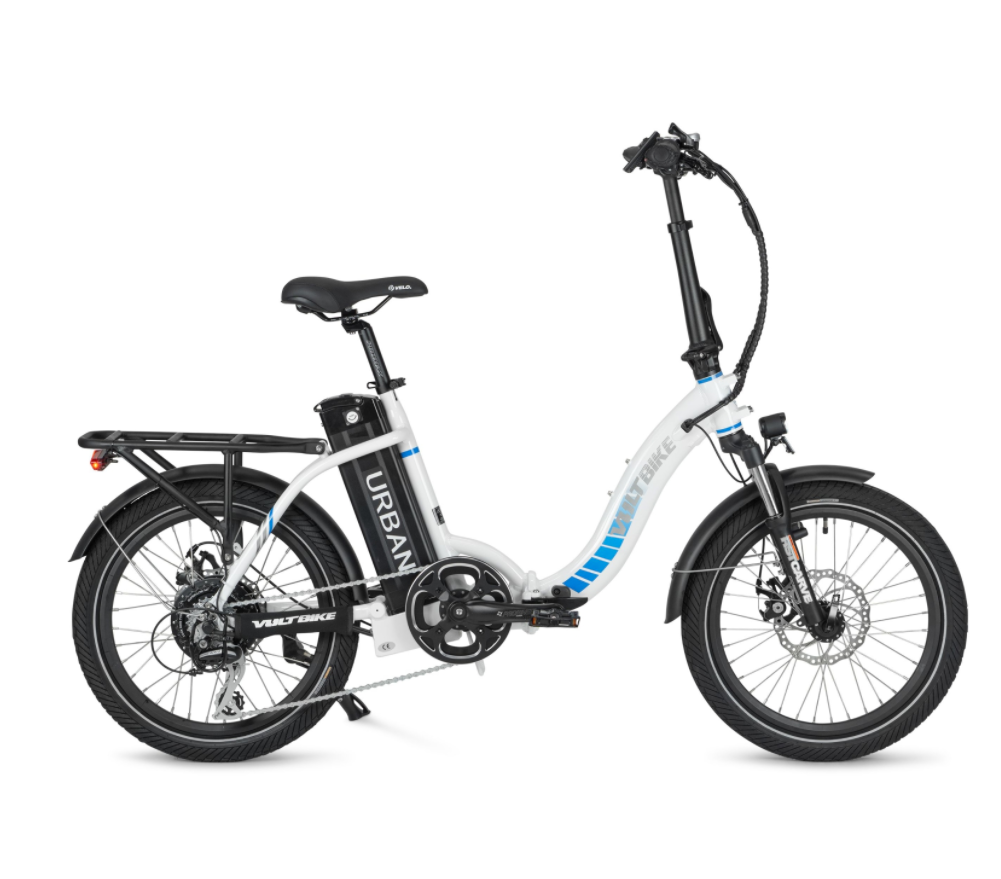 1. Step-through frame (V-frame)
1. Step-through frame (V-frame)
The Step-Through frame, as the name implies, literally makes it easy for you to step through to get onto and off the bike, making mounting and dismounting simple without having to raise your leg. This makes them great options for those with limited mobility, older riders, casual riders, and those who might be riding to work in clothing that isn’t as flexible, such as a suit or dress pants. There is no top tube on these bikes: rather, the front of the bike slopes down and extends to the back. The seat, meanwhile, is in an upright position. Step-through e-bikes tend to have thicker frames and can be heavier, but they are also sturdy and safe. However, keep in mind that if you ride a lot on hilly terrain, they can feel a bit wobbly.
2. Step-over frame (A-frame)
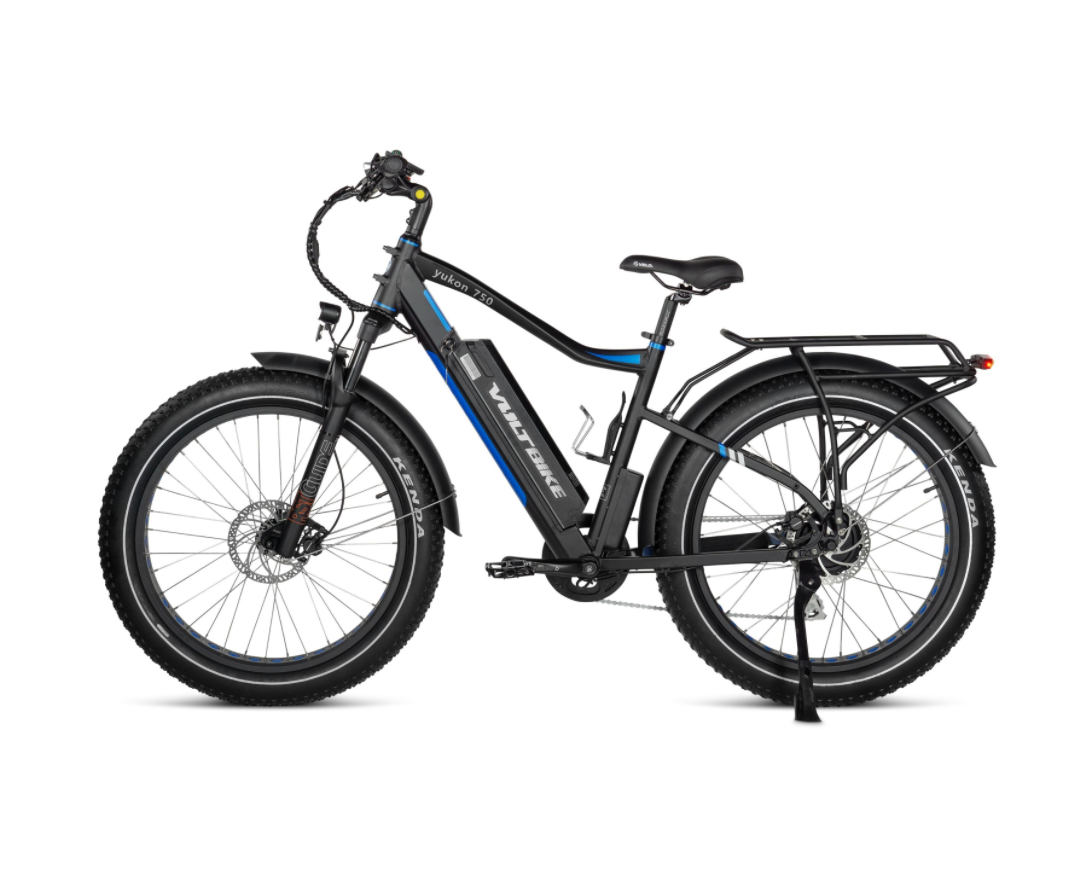 Conversely, e-bikes with a Step-over frame have a diamond or triangle-shaped frame so you need to step over and onto the bike, then raise your leg to dismount it. They are commonly found in city and road bikes, mountain bikes, high-end racing bikes, and hybrid bikes. They usually offer more pedal power than e-bikes with Step-through frames along with an overall more balanced ride.
Conversely, e-bikes with a Step-over frame have a diamond or triangle-shaped frame so you need to step over and onto the bike, then raise your leg to dismount it. They are commonly found in city and road bikes, mountain bikes, high-end racing bikes, and hybrid bikes. They usually offer more pedal power than e-bikes with Step-through frames along with an overall more balanced ride.
They are designed for riding in all types of terrain, and because they are lightweight, they can go pretty fast. But keep in mind they aren’t ideal for riding in extreme weather conditions nor for heavier rides. You might also need to consider specialized tires for Step-over frame e-bikes based on where you want to ride most often, whether it’s streets or off-road.
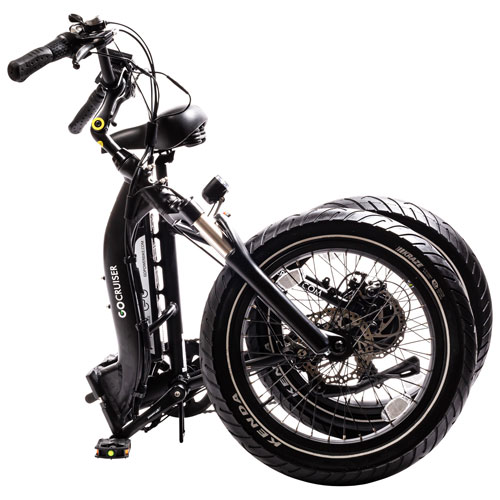
3. Foldable frame
Foldable e-bikes are designed to be compact and lightweight, making them ideal for commuting, travelling, or simply storing in tight spaces. They can be easily folded down to a fraction of their full size, allowing them to be transported in the trunk of a car or stored in a small apartment. This type of frame is also ideal for those who need to take their e-bike on public transportation or store it in a locker at work. Despite their compact size, these e-bikes are still powerful and efficient, with many models featuring advanced motor and battery technology to ensure a smooth and enjoyable ride in a variety of conditions.
Typical range and speed of an e-bike
How fast does an e-bike actually go? Most Canadian provinces regulate that you should not go faster than 32 km/h. on an e-bike, regardless of its capabilities. Speed can vary for an e-bike from topping out at 29 km/h to reaching speeds in excess of 45 km/h. Most e-bikes will shut down the motor once it reaches its top speed. While you might want a super-fast e-bike, consider the regulations in your province and choose accordingly.
In terms of range (distance travelled) per battery charge, this too can vary considerably. Most e-bikes are rated at anywhere from 24km per charge up to as much as 97km. But keep in mind that other factors will impact range, including your weight and the weight of any cargo you’re carrying, the terrain you’re riding on, the steepness of hills you climb, the wind, and how much you pedal versus relying on the motor. But basically, you should be able to get as far as somewhere that would typically be a 10-15-minute drive away without issue with most e-bikes.
Once ready to recharge, simply plug the bike in and it should fully charge in 3.5 to 6 hours. The average cost to run and maintain an e-bike will depend on the price of electricity in your area and many other factors. While it’s more costly than a regular bike, it’s also significantly less than a car.
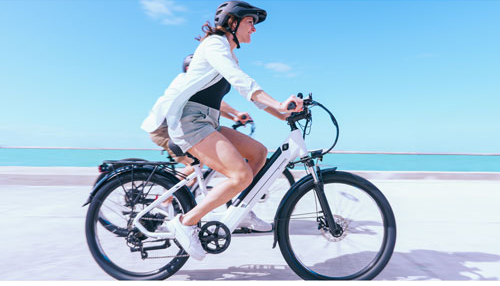
If you’re considering purchasing an e-bike in Canada, it’s important to familiarize yourself with the regulations in your province. In most provinces, including Alberta, British Columbia, and Ontario, e-bikes are approved for use and do not require a license to operate. However, regulations vary by province and may be different based on the terrain you’ll be riding on.
Generally, e-bikes are required to have a maximum output of 500 watts and a maximum speed of 32 km/h, except for Manitoba where the speed limit is 50 km/h. Riders are typically required to wear a helmet and follow the same traffic rules as a regular bike. It’s also important to note that some provinces have minimum age requirements for e-bike riders, ranging from 12 to 18+. Before making a purchase, be sure to research the regulations in your province and ensure that the bike meets the necessary criteria.
Types of electric bikes
Just like standard bicycles, electric bikes come in a variety of types, each with its own advantages and features that will appeal to different riders, needs, situations, and settings. There are two core types of e-bikes: city/commuter e-bikes and off-road e-bikes. In each, there are also sub-categories. Let’s cover them.
1. City and commuter bikes
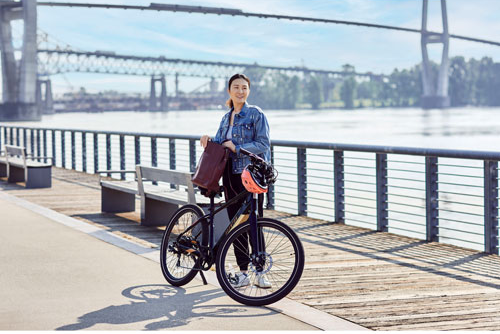
Electric city and commuter bikes are designed for those with heavy commuting needs, such as those who ride to work or school and back on a daily basis, do deliveries, or travel primarily by bike around the busy city and urban areas. They are often among the fastest types of electric bikes and offer the longest range per charge as well. You’ll find that many have a rack for cargo, like a backpack, groceries, and other items. They are built to be sturdy so they can carry both you and your gear and are able to withstand loads of stress. They are less aerodynamic than a road e-bike but also more comfortable with an upright seated position. The strong frames, usually made of steel, are made to support the extra weight. There’s support for different attachments, including racks and fenders.
An electric city or commuter bike is best for city dwellers who travel often for both short and long distances and bring along some cargo with them. They’re one of the most popular e-bike options that will suit most people. You’ll find several sub-categories of electric city/commuter bikes.
- Electric cruiser bikes
An electric cruiser bike is more for casual and recreational riders, allowing you to sit laid back in a large, comfortable seat as you, as the name implies, cruise around the city, on the walkway at the beach, or around your neighbourhood. Great for getting a bit of exercise or running short errands, they often have a step-through versus step-over frame for easily mounting and dismounting without having to raise your leg over a bar and usually have swept back handlebars. For older riders and those with limited mobility, or if you’re riding to work in a dress or suit, electric cruiser bikes are a good option. They sometimes come with accessories like a basket, bag, or rack. They do, however, tend to be thicker and heavier, and they aren’t the best option for long distances nor for getting over hills since you might find them to be a bit wobbly.
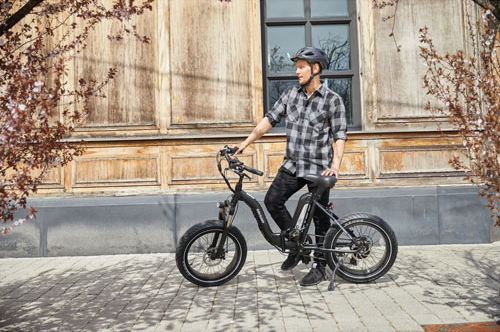
Who it’s best for – Electric cruiser bikes are ideal for casual and recreational riders who might go out every now and then, or ride short distances to run errands, visit friends, and get exercise. They aren’t great for hilly terrain, though. They’re best for riding on smooth, flat surfaces. With a step-through frame, they’re also recommended for those with mobility issues as well.
- Electric cargo bikes
An electric cargo bike is a larger e-bike that is specifically designed to carry cargo. This can range from groceries and boxed items for deliveries, to even another person, like a child. They have been popular for some time in countries like Denmark and are starting to gain steam in North America. They are a viable, cost-effective alternative to using a car when you only need to run short errands or go short distances but still need to bring some cargo along with you. The storage area can be in front of or behind the handlebars. These e-bikes offer higher power since they are designed to carry extra weight, which means they’re also very stable. It’s important to look at the payload or max carrying capacity for cargo bikes to ensure they will meet your needs. Factor accessories into the cost of one of these e-bikes, including things like racks and child seats, just as you would need for a car.
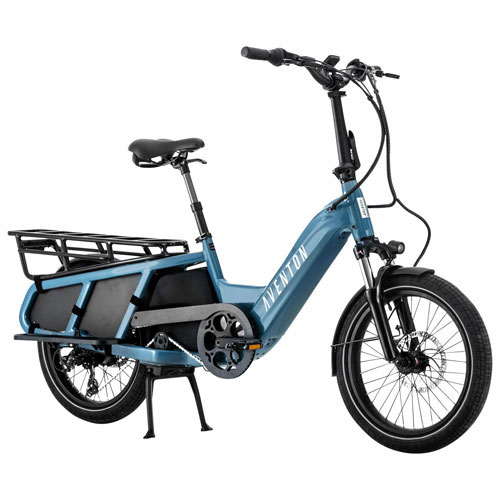
Who it’s best for – Electric cargo bikes are ideal for those who not only ride often, but who might not even own a car and want to use the electric cargo bike to get around the city. That might include taking a child (or kids!) to school, grabbing groceries, or even doing deliveries.
- Electric road bikes
An electric road bike has drop handlebars so you’re sitting in a sportier position than you would use a hybrid e-bike. It’s similar to a road or gravel bicycle, and to an electric city or commuter bike, with the names often used interchangeably. They are great for long distances, especially given the lightweight design and aluminum or carbon frame that is made for speed. These are good for paved roads and mixed surfaces like trails and bike paths. Usually with step-over frames and drop-down handlebars with narrow tires, you’ll sit in the more aggressive, facing forward riding position.
Who it’s best for – Like with electric city or commuter bikes, electric road bikes are ideal for heavy commuters who need good power, durable build, and fast speed.
2. Electric off-road bikes
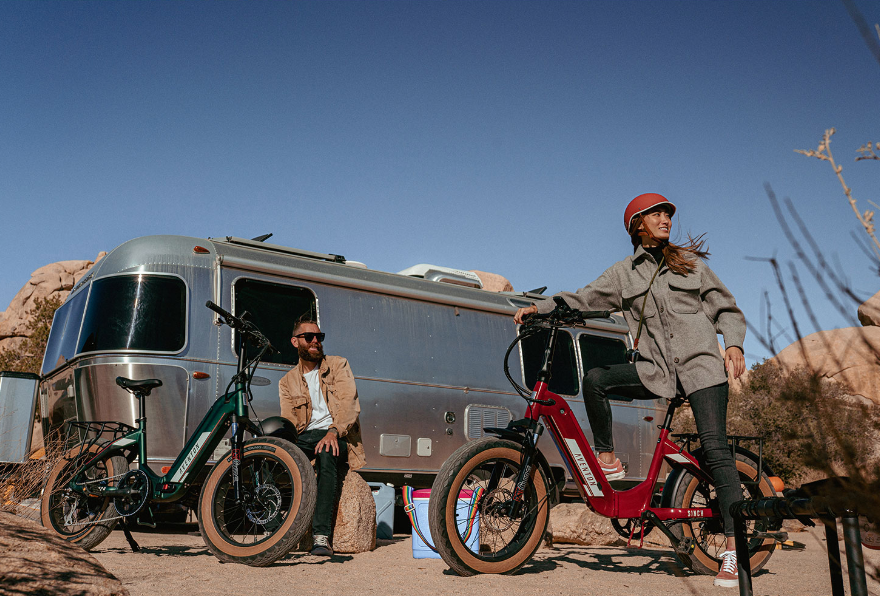
Also known as a mountain bikes, electric off-road or rugged terrain bikes are similar to off-road or mountain bicycles. These typically have thicker tires, and a more durable suspension system, and are built ruggedly to withstand any terrain. Fat tire versions either come with or can be upgraded to tires that are 4 inches wide versus the standard 2-3 inches you get with other e-bikes. These are worth considering if you’ll need better traction, stability, and comfort while riding through especially bumpy and rugged terrain, including snow and even sand. Adjust pressure to go fully inflated for paved roads and deflated for soft or rocky terrain.
You can go farther with these bikes and ride quickly with less effort thanks to the electric power option. An off-road bike also makes it easier to scale larger hills and inclines, offering better stability and control than you’d find with other types of electric bikes.
Who it’s best for – Electric off-road bikes are best for adventurers who will be traveling through various types of terrain, like at the beach, while in the mountains, traveling to the countryside, or going on trails with steep hills and inclines.
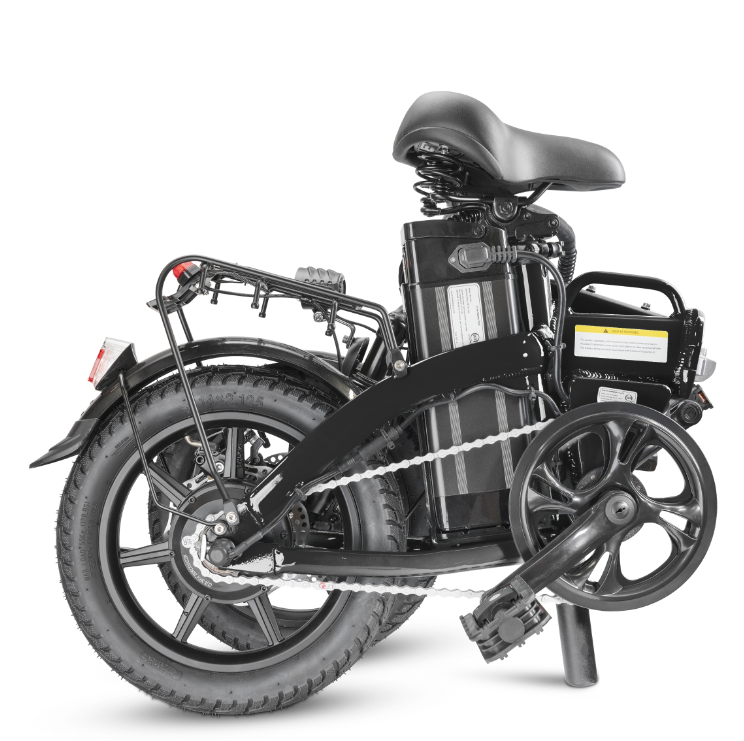
3. Electric foldable bikes
Electric foldable bikes are found across most categories of electric bikes. It’s a nice feature for those with minimal storage space or who want to travel with the electric bike, bringing it in the trunk of a car, for example, on a road trip, up to the cottage, or to a friend or family member’s house to ride together in their area. It can save plenty of space, particularly for those who only ride during certain seasons and want to store the bike neatly away for the winter.
Who it’s best for – Opt for an electric foldable bike if you’re a rider who will want to bring the bike along to different locations, from the cottage to a riding partner’s home in another city. These are also useful if you have limited storage space, or only ride during specific times of the year and have the bike packed away from months at a time.
What other factors should you consider when choosing an e-bike?
Now that you are seriously considering an e-bike, what else should you consider while browsing the options?
1. Budget
One of the most important considerations is budget. E-bikes can range in price considerably from $800 up to $3,000, so you’ll need to narrow your budget first. If you know your limit, you can use the handy filtering tool on the Best Buy website to filter by price and only see options that fit your range.
2. Lifespan and durability of the battery
As with lithium-ion batteries in any electronic device, they will lose capacity over time, so keeping the bike properly stored when not in use and ensuring the sealed battery compartment is properly sealed and cared for will help extend its life. Avoid leaving the battery fully charged or discharged for long periods of time and recharge it every so often to keep it fresh, ideally up to about 30-60% each time. The battery should provide about 500-1,000 charge cycles, which typically lasts about 4-5 years depending on usage.
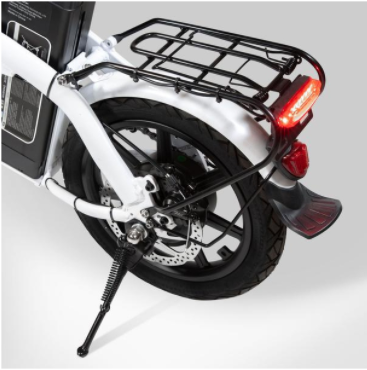
3. Tire selection and replacement
As noted, keep the tires at optimal pressure levels at all times, and make sure you use the right tires for the right conditions based on where you plan to ride. Some e-bikes come with all-terrain tires, but you can always swap out for something more suited to your plans if you plan on taking it on adventures.
4. Speed and gears
Along with a pedal assist and full electric mode, you want to make sure the bike has different speeds and levels so you can adjust as needed based on your comfort level, endurance, where you’re going, how much you want to pedal, and even to conserve battery levels in a pinch.
5. Safety features
If you plan to ride at night or alone, you might want to look into bikes that come with additional safety features, like built-in headlights and/or taillights. An e-bike with manual brakes is also important for safety, if there’s an issue with the battery or mechanisms, and especially when doing big-city riding or with young children. Some e-bikes come with a dual-disc braking system, which is great for safety.
Find the right e-bike for you
With so many e-bike options, it can be daunting to figure out the right type of e-bike for you. First determine what type of standard bicycle you would be buying, or perhaps already own. Chances are that the electric bike equivalent to that bicycle would be the best option.
Consider where you ride, whether it’s smooth paved roads or rougher terrain when you ride, and how often. If you plan to take the bike with you often, like up to your cottage on the weekends, a foldable e-bike is a worthwhile option to consider in whatever main e-bike category you choose.
Once you have narrowed down the type of e-bike you’re interested in, check out our article on How to choose the right size e-bike to help you make the right decision about sizing considerations based on your height, body type, and frame.
Take the next step
Now that you have learned a lot about electric bikes you are well on your way to exploring the city, trails, and the great outdoors with ease. Once you’re ready to take the leap, check out a wide selection of electric bikes at Best Buy Online.



